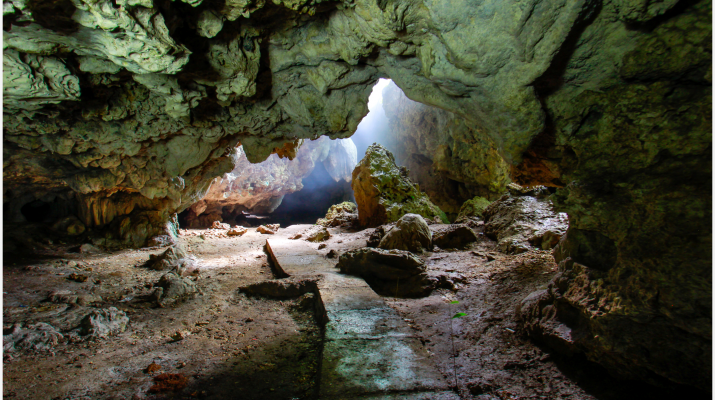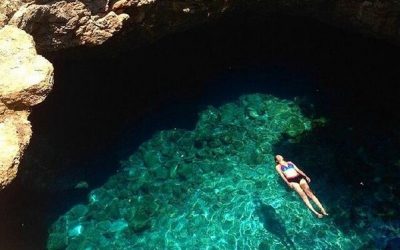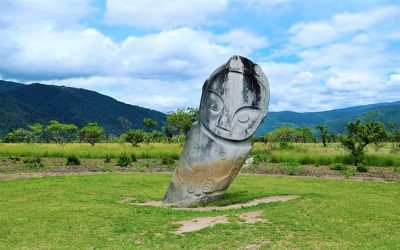Cultural Destination
Pamona Cave
Pamona Cave (Photo: @festivaljalanjalan)
Pamona Cave
Rumor has it, that this cave is the house of some death bodies from Pamona Tribe. Apart from the mystery surrounding this cave, visitors can explore all the area. A little reminder: make sure to bring your own equipment to have a walk inside
Natural Tourism Destination
Pamona Cave
Tourist Attractions in Central Kalimantan
Pusentasi – Donggala Sea Well
Pusentasi of Donggala sea well is one of the natural phenomena in Central Sulawesi. Pusentasi literally means
Pulau Dua in Banggai
If you want to have an adventure getaway in nature paradise, Pulau Dua is one of a kind. It is situated in
Lore Lindu National Park
Designated as part of the UNESCO World Network of Biosphere Reserves, Lore Lindu National Park is
Central Sulawesi
Batik Motifs
Taiganja
Taiganja is a precious gold pendant that shows the social status of the Kaili family. It is
Cengkeh
The clove flower motif is the main commodity of the Tolitoli Regency. This motif represents
Sero Tangga
The Sero Tangga illustrates an endearing feeling and sacrifices of a person to fulfil
Bomba Mawar
This motif means sacred love for family, kingdom, and God; It also illustrates
Discover
Indonesian
Batik
Motifs
Sero Tangga
The Sero Tangga illustrates an endearing feeling and sacrifices of a person to fulfil
Jumputan Bintang
The word Jumputan means the tie-dye technique, while the word “Bintang” refers to
Prada Papua
The word “Prada” in the Javanese-Indonesian dialect means a batik textile that
Kasih Tak Sampai
‘Kasih Tak Sampai’ is an idiom in the Indonesian language which refers to
Parang Rusak
Another meaning behind this motif is an unconquerable spirit, symbolized by
Gigi Haruan Lidi
The Gigi Haruan Lidi motif is taken from the name of the cork fish and is a symbol of
Awan Berarak
Awan Berarak is a combination of Dayak motifs and Malay patterns. The word ‘Awan Berarak’ means the
Wirasat
Wirasat or divine inspiration is a gift from God. This inspiration is symbolized by
Lontara
The Lontara script itself is a typical ancient script of Bugis and Makassar communities. History records that
Dayak Taghol
Dayak Taghol has a distinctive style of four curved lines and small dots. This motif represents
Srimanganti
The name of the Srimanganti motif is derived from Palace’s hallway that connects to
Bale Lumbu
This motif signifies the welfare of the ancient Sasak society. Bale also symbolizes the
Gurdo Solo
Gurdo or garuda bird is the mount of the Indian god Vishnu. As the Sun Bird,
Bomba Mawar
This motif means sacred love for family, kingdom, and God; It also illustrates
Bekantan Pakis
This motif represents Pakis Haji (Polystichum setiferum), an endemic plant in
Pucuk Rebung Riau
Pucuk Rebung symbolizes heart determination in achieving goals, good luck, and
Ukir Sentani
The Ukir motif is a batik motif that is inspired by various traditional Sentani wood carvings
Pala Salawaku
This motif illustrates the unique weapons of the Maluku region, namely
Gajah Way Kambas
The motif illustrates the Lampung’s natural reserve, the Way Kambas. it also symbolizes
Tengkawang Ampiek
With its many advantages, the Dayaks use this leaf in ritual ceremonies. This plant is a symbol of
Buketan Bali
The Balinese bouquet (Buketan Bali) is a floral arrangement and the name is
Burung Bidadari
Bidadari birds are endemic birds in Halmahera. This motif represents an
Manguni Minahasa
Manguni is identified as the symbol of the Minahasa people. Manguni is known as a
Merak Ngeram
The hatching peacock motif has a very deep meaning which refers to the sacrifice and
Ake Patra
Ake is related to the divinity and the composition of the universe. It is a symbol of
Keluak Daun Pakis
The word “Keluak” is a Minang language which means twisted or tangled. The Motif of
Kain Cual
Cual textile tradition has existed since the 17th century. The word “Cual” refers to
Pohon Hayat (Tree of Life)
The Batik motifs in Lampung are dominated by the acculturation of Buddhist and
Sekomandi
Its philosophical meaning is the eternal union which refers to a saying “until death do us part”
Raja Ampat
Raja Ampat motif represents the marine life at Raja Ampat archipelago in
Rangkiang
The word “Rangkiang” refers to the rice granary in the Minangkabau language. It symbolizes
Kawung
The Kawung motif was created by Sultan Agung Hanyokrokusumo (1593 – 1645) as a symbolic gift for
Bintik Tujuh
The Bintik Tujuh (Seven Dots) motif has 7 white spots and green color gradation as
Singayaksa
The Singayaksa motif comes from the name of a place where Sultan Hasanuddin used to
Gonggong Beruntun
This motif illustrates that a person should maintain a positive attitude and
Enggang Dayak
Local people beliefs that hornbills are an incarnation of the Commander of the Birds. It has supernatural
Daun Lada Hitam
The black pepper motif represents the main commodity of Bangka Belitung
Tangerang Herang
Tangerang Herang motif is a symbol of Tangerang city. The Tangerang Herang batik motif consists of
Ikan tambal
The word “Ikan” refers to fish. The philosophical meaning of Ikan Tambal means is
Lok Baintan Floating Market
As you can imagine, the most authentic thing is that you can buy things and even
Tabir Tanjung
Tanjung flower is a type of Cherry tree flower, which is commonly found in
Desa Na Tolu
The Desa Na Tolu characteristic pattern symbolizes the Batak philosophy of existence and
Sandeq
Sandeq Boat is a symbol of the maritime importance of the West Sulawesi region. The greatness of
Hiu Taliyasan
Indonesia is also home to the world’s largest fish, the whale shark (Rhincodon typus). Hiu Taliyasan refers to
Daun Simpor
This motif is inspired by the Simpor plant (Dillenia Suffruticosa) which is a typical
Rumah Mamuju
the Batik motif illustrates the house of Mamuju King with the stairs, located on the left of the wooden stage house
Gonggong Siput
Gonggong (Strombus Turturella) is one type of sea snail found around
Bultiya
The word ‘Bultiya’ is an acronym of the three major tribes in North Kalimantan, namely
Teguh Bersatu
This batik motif shows the strength of the people of Kupang. It also represents a sense of
Karawo Mahkuta
Mahkuta refers to Gorontalo’s traditional crown. It represents noble characters of
Pinawetengan
The Pinawetengan Batik pattern was taken from a prehistoric inscription in
Tampuk Manggis Sasirangan
The motif illustrates the philosophy of the mangosteen fruit, which is
Tubo Kelapa
Coconut tree is a symbol of a good character and strong mentality. It illustrates the more success a person, the more
Tongkonan
Toraja’s traditional house is called Tongkonan. Tongkonan is a place for
Paqbarre Allo
The word “Barre” means round and “Allo” means the sunlight. This motif is interpreted as
Gorga Simeol-Meol
The Gorga Simeol-meol is a pattern of plant tendrils. it is regarded as a symbol of longevity and
Pati-Pati Pinehiku
It symbolizes the hierarchy in society and the social status of the Mekongga
Malinau Cultural Festival
You will witness a unique competition that might not be found other than in
Taiganja
Taiganja is a precious gold pendant that shows the social status of the Kaili family. It is
Kuda Kupang
Horses symbolize wealth. It contains noble values of virtuous characters that bring
Insang Ikan
Insang refers to the gills of the fish. This is a typical pattern of Malay ethnic who inhabits
Jupri Kembang Teh
Kembang Teh illustrates the tendrils of tea plants that grow in the highlands of
Gamolan
This motif illustrates Gamolan, a bamboo musical instrument of Lampung that is
Pattimura
Pattimura is the name of an Indonesian hero who fought against colonialism in
Gedhog Kembang Waluh
a combination of Javanese cultural motif of the Majapahit kingdom (XII-XIV century) with
Dayak Kamang
Kamang motif is generally found in the Dayak tribe shield because it is believed to
Leuit Sijimat
This motif reflects the daily activities of the Baduy tribe in Banten. The main ornaments of batik motif consist of:
Tifa Totobuang
The batik motifs illustrate Maluku’s traditional music instrument called
Besurek Rafflesia
The term “Basurek” refers to a textile that contains letters or inscriptions
Besurek Rembulan
This batik illustrates praise for God who created the wonderful universe
Lipaq Sabe
Lipaq Saqbe contains a simple geometric classical motif with various flower decorations. This textile is
Kaharingan
The Kaharingan or ‘tree of life’ based on the Dayak tribes’ belief system. This tree symbolizes




